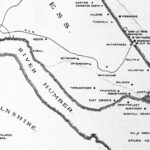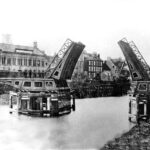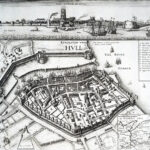27 June 1778: Civil engineer John Smeaton reviews the construction for London Trinity House of two lighthouses on Spurn Point, eroding from seawards and growing southwards into the mouth of the Humber
John Smeaton. 1812. Reports of the Late John Smeaton, F.R.S., Made on Various Occasions, in the Course of His Employment as a Civil Engineer, Vol. 1/3. London: Longman, Hurst, Rees, Orme, and Brown. Get it:
.Excerpt
It was not till the year 1771 that the buildings were begun to be erected, when on revisiting the point I found that it had so much increased in length that it projected at high water mark 280 yards further out than it did in the year 1766. The land had also increased on the side next the Humber, but had shown a very apparent diminution to seaward. Under these circumstances, it did not seem at all prudent to carry the line of the building further from the point than had been directed, nor, on account of the diminution to seaward, to carry it further out; but finding room on the side next the Humber, I advised that they should be carried 80 yards further towards the Humber, upon the same line, than originally they had been proposed, which seemed to be a very ample allowance for the encroachment of the sea, that hitherto was not supposed to be any other than casual, and that therefore in all probability would increase again on that side as well as the rest. During the carrying on of these buildings, I not only remarked that the sea was making gradual approaches toward the lesser lighthouse, but was wearing away the solid land of the coast for many miles to the north of the Spurn. However, its progress was not such as to denote any immediate destruction, till a great storm happening in January 1776 that in two tides made such an encroachment upon the land as to take away the ground from under a part of the foundation of the circular wall and washed away the ground so as to lay bare a part of the piling upon which the main building stood. I defended the building with a large quantity of Hazlecliff [Hazlewood, Skipton] rubble stone. Seeing from the gradual wasting of the whole coast that nothing could be a permanent defence to this building but what would defend it as an island, after the sea had taken the land away round about it, and as this could not be done but at the expense of some thousand pounds, a much greater expense than what would erect a new building, I therefore advised, as the cheapest defence that could be made, so as to give it the best chance for a time, to rebuild the circular wall, founding it as deep as we were able at a moderate expense, and setting it upon piles, and surrounding the wall also with a slope of Hazlecliff stone, and, as a last resort, to erect the large temporary light machine in the line of the two buildings, 30 yards from the centre of the smaller lighthouse more inland, and to repair and fit up the same ready for lighting, at two hours warning, so that in case any sudden or violent storm should render the house unfit for service, recourse could immediately be had to the machine light to continue the duty.
Comment
Comment
My wild supposition that the Hazlecliffe/Hazelcliff stone came from Hazlewood-with-Storiths is based on serendipitous mention of sandstone quarries there (Historic England 2023) – I have no idea whether stone could have been transported from that high on the Wharfe, nor whether it would have been suitable (surely not) – better suggestions welcome.
Re the erosion at nearby Hornsea, the following doggerel:
Hornsea steeple when I built thee,
Thou wert ten miles off Burlington,
Ten miles off Beverley,
And ten miles from the sea.
(Northall 1892).
Something to say? Get in touch
Original
The Report of JOHN SMEATON, Engineer, upon the state and condition of the low light-house at Spurn Point, pointing out the most likely means of preserving the same at a moderate expence.
IN the year 1766, I attended a deputation of gentlemen of the Trinity-Houses of Deptford Strand and of Hull, who were also attended by Capt. MITCHELL, who was supposed to know the coast the best of any body: he had previously set up marks for the placing of the light-houses, according to his own opinion; the line of direction was the same in which they now stand as to the points of the compass, but was more inland, that is, further from the Point than the line upon which the present buildings stand. It was then observed by the gentlemen, that the removal of the present light-house was on account of its being too far from the Point; and as the Point appeared to be increasing, and going out further and further yearly, that the new light-houses might not soon become again necessary to be removed and rebuilt, it was desirable to have them as near the Point as possible, as the probability was, that they would by the increase of the Point leave the houses more and more within the land. The only difficulty then seemed to be, whether the buildings could be so founded as to stand upright upon this great bed of sand, if built so much nearer the high water mark, upon which I said I could undertake to make foundations upon any part of the bed of sand, so as to enable the buildings to stand upright upon their bases, provided they were out of the way of the immediate stroke of the sea; and as it was universally allowed by all present that the land was increasing there in every direction, there could be little danger of a direct attack of the sea upon either building, and therefore the gentlemen ordered marks to be put down in the line on which they now stand, at the distance of 300 yards from each other, and which line was then only 115 yards distant from the extreme point at high water mark.
It was not till the year 1771 that the buildings were begun to be erected, when on revisiting the Point I found that it had so much increased in length that it projected at high water mark 280 yards further out than it did in the year 1766. The land had also increased on the side next the Humber, but had shewn a very apparent diminution to seaward. It had been determined to begin with the small light-house first, which being a less ponderous building, if any difficulty should arise in making a foundation, it might be a forewarning, and thereby furnish the means of conquering the difficulties that might attend the larger and more ponderous building.
Under these circumstances of the Point’s having lengthened 280 yards in five years, it did not seem at all prudent to carry the line of the building further from the Point than had been directed, nor, on account of the diminution to seaward, to carry it further out; but finding room on the side next the Humber, I advised that they should be carried 80 yards further towards the Humber, upon the same line, than originally they had been proposed, and accordingly the foundation of the smaller light-house in question was laid 80 yards more inland than originally marked out, being there no less than 90 yards within land from high water mark, which seemed to be a very ample allowance for the incroachment of the sea, that hitherto was not supposed to be any other than casual, and that therefore in all probability would increase again on that side as well as the rest: I also on this account ordered the foundation of the building to be furnished with a greater number of piles than originally intended. Having never been at the Spurn otherwise than by water, previous to the laying the foundation of the lesser lighthouse, it was not till that building was considerably advanced that I had an opportunity of remarking the progressive effect of the sea upon the coast, which my frequent journies by land during the progress of the work gave me an opportunity of seeing. In the year 1772 the great light-house was founded, and though there appeared no diminution of the land on that side, yet by way of precaution I advised it to be set only 60 yards from its first intended position towards the Humber, instead of 80, which kept it 20 yards further from the Humber than according to the former position, and also by way of further security, I ordered this foundation to have an additional number of piles in like manner as the former. During the carrying on of these buildings, I not only remarked that the sea was making gradual approaches toward the lesser light-house, but was wearing away the solid land of the coast for many miles to the north of the Spurn: however, its progress was not such as to denote any immediate destruction, till a great storm happening in January, 1776, that in two tides made such an incroachment upon the land as to take away the ground from under a part of the foundation of the circular wall, which occasioned one half of it to be beat down, and washed away the ground so as to lay bare a part of the piling upon which the main building stood; and had it not been for the precaution of the additional number of piles in its first founding, it most certainly had given way; however, there did not happen the least shrink.
On this alarming occasion, I defended the building with all the expedition that could be used by a large quantity of Hazlecliff rubble stone, forming a slope against the side of it to seaward, and in the advance of the spring the sea rather retreated than further wasted the ground. Seeing therefore, from the gradual wasting of the whole coast, that nothing could be a permanent defence to this building but what would defend it as an island, after the sea had taken the land away round about it, and as this could not be done but at the expence of some thousand pounds, a much greater expence than what would erect a new building, I therefore advised, as the cheapest defence that could be made, so as to give it the best chance for a time, to rebuild the circular wall, founding it as deep as we were able at a moderate expence, and setting it upon piles, and surrounding the wall also with a slope of Hazlecliff stone, and, as a dernier resort, to erect the large temporary light machine in the line of the two buildings, 30 yards from the center of the smaller light-house more inland, and to repair and fit up the same ready for lighting, at two hours warning, so that in case any sudden or violent storm should render the house unfit for service, recourse could immediately be had to the machine light to continue the duty, all which was executed in the course of the following summer.
The beginning of the year 1777 there happened another violent storm at N. E. which the work sustained without any other derangement than that a part of the Hazlecliff stones laid on the outside of the wall was dispersed; therefore, after seeing the effects of this storm, I left it as my last advice, that “as storms of this kind must be expected every winter, there did not appear to me (though a temporary defence) any thing more likely to be effectual, or to afford a better chance of saving the building for a term of years, (without going into expences that cannot with any degree of propriety be supported, as being greater than the expences of the building itself,) than a proper application of Hazlecliff stones; I therefore recommended that for the present year (1777) 150 tons of Hazlecliff stones be got to the place ready to be applied as heretofore, that is, as it may be wanted, apprehending it is very possible that after they have got into the way of using the stones in a less body, and occasionally as they are wanted, that 100 tons annually might suffice, that is, till an extraordinary revolution happens, for in that case I don’t apprehend that 1000 tons would be effectual.”
At the same time I observed, that the high light machine being erected upon the line, it can in two hours be lighted, so that no damage can happen to the navigation by any failure of exhibiting proper lights; and as the machine is placed upon ground walls, by continuing these walls and getting the machine upon rollers, it can with great ease be drawn further within land, whenever the wearing away of the coast shall require it.
Austhorpe, 27th June, 1778.
J. SMEATON.
1512 words.
Similar
 3 May 1343: Short of cash for his French wars, Edward III asks what the effect on his rental income will be of January storms and coastal erosion at Ravenser Odd (Holderness)
3 May 1343: Short of cash for his French wars, Edward III asks what the effect on his rental income will be of January storms and coastal erosion at Ravenser Odd (Holderness) 1 July 1840: The opening of the Hull and Selby Railway terminates the threat to Hull’s port from Goole, Scarborough and Bridlington
1 July 1840: The opening of the Hull and Selby Railway terminates the threat to Hull’s port from Goole, Scarborough and Bridlington 17 August 1778: Civil engineers John Smeaton and John Wooler explain how to use the River Hull to flush the dock which has replaced the northwest section of the city walls
17 August 1778: Civil engineers John Smeaton and John Wooler explain how to use the River Hull to flush the dock which has replaced the northwest section of the city walls 3 July 1837: The Swan, a Hull whaler, returns from the dead (the ice of the Davis Strait) bearing three whales
3 July 1837: The Swan, a Hull whaler, returns from the dead (the ice of the Davis Strait) bearing three whalesSearch
Donate
Music & books
Place-People-Play: Childcare (and the Kazookestra) on the Headingley/Weetwood borders next to Meanwood Park.
Music from and about Yorkshire by Leeds's Singing Organ-Grinder.


 Bluesky
Bluesky Extwitter
Extwitter